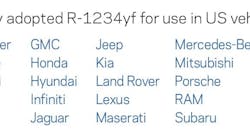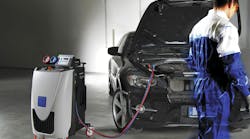Can electromagnetic fields (EMF) damage your health? Even though there has never been conclusive scientific evidence establishing a relationship between EMF and cancer, there are some who continue to suggest that it can have adverse health consequences. Power lines, WiFi, cell phones, etc. all emit EMF. Because spot welders also emit EMF, collision repair facilities have now been brought into the debate. The European Union has introduced legislation of a preventative nature designed to keep EMF from becoming a health hazard in the workplace as a part of their worker protection laws. On April 30, 2008, Directive 2004/40/EC (EMF directive) of the European Parliament becomes law across the European Union. What is this directive? And why should American collision repair facilities care about it? Initially, there is a possibility that a similar law may someday be passed here in the United States. Another reason is that there are some who would unscrupulously use scare tactics coupled with a general lack of awareness about the specifics of this law to promote their “compliant” spot welding machines. This article seeks only to raise awareness of the facts about this European law, and what (if any) ramifications there are for American collision repair facilities. What is the intent of the EMF directive? The EMF directive builds upon a prior directive (89/391/EEC) that is aimed at encouraging improvements in the safety and health of workers in the workplace. The EMF directive’s aim is to protect workers from risks associated with exposure to EMF. To quote the directive, “the long-term effects, including possible carcinogenic effects due to exposure to time-varying electric, magnetic and electromagnetic fields for which there is no conclusive scientific evidence establishing a causal relationship, are not addressed by this directive” So, to put it simply, the directive is meant to avoid adverse effects on the cardiovascular and central nervous systems of workers due to short term exposure to EMF in the workplace. What are the specifics of the EMF directive? The EMF directive applies to EMF exposure in the frequency range up to 300 GHz, whatever the source. There are two different values specified. Exposure limit values are values that cannot be exceeded under any circumstance. Action values are values that can be exceeded, however they serve as an indication that further investigation is necessary. If the investigation shows that the exposure limit values have been exceeded, corrective action must be taken to prevent this from happening again. Who is responsible for compliance with the EMF directive? The EMF directive applies to the workplace as a whole, thus it is the employer who must demonstrate that his business’ workplace complies with the directive. The employer must perform a risk assessment, which is carried out by a competent source and must be regularly updated. This risk assessment should demonstrate compliance with the EMF directive, and must be filed according to the national law where the company is located. The employer will also provide training to the workforce regarding the directive and its implementation. Where overexposure is identified, the employee is entitled to a medical examination, and corrective action must be taken to prevent this from happening again. Does the EMF directive outdate all current spot welders? This is a difficult question to answer, as even taking measurements and calculating workers’ exposure to EMF can be very difficult. To illustrate this, think of how many different positions a technician may have to use the welder when performing repairs to various areas of a vehicle. Due to this, the European Standard Organization CENELEC has been asked to develop a standard for this specific issue. Evidence of compliance by equipment manufacturers: Equipment manufacturers are required to provide information about the electromagnetic fields produced by their products for use when making the risk assessments. Several European car manufacturers such as DaimlerChrysler AG, Renault and Peugeot, have revoked approvals of all spot welding equipment and are requiring the equipment manufacturers to re-apply for approval, including certification that their equipment complies with the EMF directive. Naturally, this information would also be of interest to any repair facilities considering the purchase of spot welding equipment. Is new technology available? Most spot welders are of the cable clamp variety, which means that the transformer is located in the body of the machine and there are thick cables that are attached to the welding clamp. EMF is emitted by electricity flowing through the cables. A new development is the transformer clamp machine, which has the transformer integrated with the welding clamp, meaning EMF is only emitted in the welding clamp, vastly cutting down the potential exposure of the operator. At the current time, there are a few companies that have transformer clamp welders on the market. So, how will all of this affect collision repair facilities here in the United States? While a law similar to the EMF directive may never be passed here in the United States, I am sure that all collision repair facilities care about the health and safety of their workers. However, keep in mind that there still has yet to be conclusive scientific evidence that there is a health hazard from EMF, and the directive is only a preventative measure. Also, there is the distinct possibility that welders currently on the market may be compliant with the EMF directive, and if they are not currently compliant, may potentially be with modification. Surely, many manufacturers are having their machines tested as we speak. I am certainly looking forward to the results of this testing, as the outcome should be very interesting.
|
Voice Your Opinion!
Voice Your Opinion!

